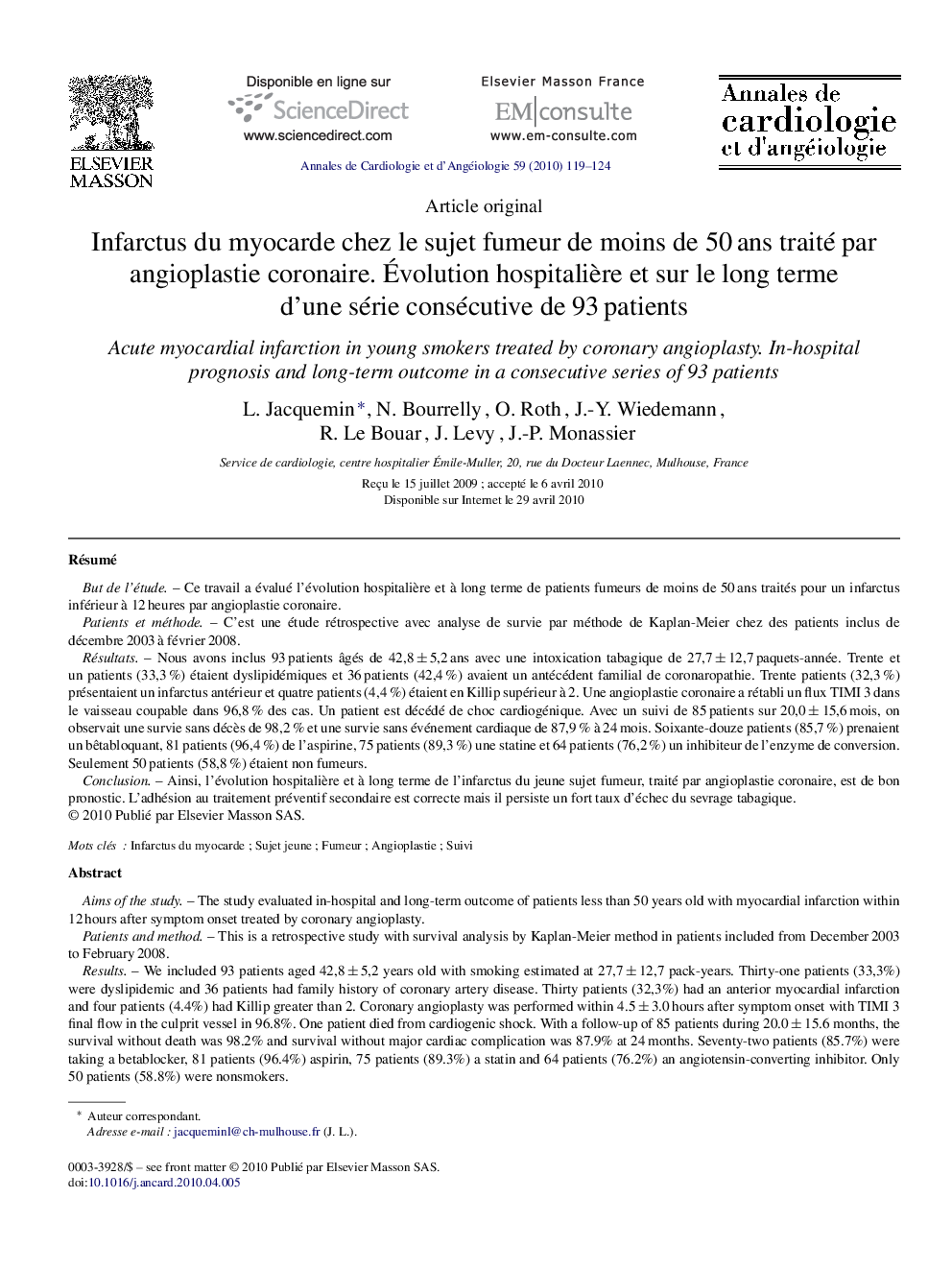| Article ID | Journal | Published Year | Pages | File Type |
|---|---|---|---|---|
| 2869322 | Annales de Cardiologie et d'Angéiologie | 2010 | 6 Pages |
RésuméBut de l’étudeCe travail a évalué l’évolution hospitalière et à long terme de patients fumeurs de moins de 50 ans traités pour un infarctus inférieur à 12 heures par angioplastie coronaire.Patients et méthodeC’est une étude rétrospective avec analyse de survie par méthode de Kaplan-Meier chez des patients inclus de décembre 2003 à février 2008.RésultatsNous avons inclus 93 patients âgés de 42,8 ± 5,2 ans avec une intoxication tabagique de 27,7 ± 12,7 paquets-année. Trente et un patients (33,3 %) étaient dyslipidémiques et 36 patients (42,4 %) avaient un antécédent familial de coronaropathie. Trente patients (32,3 %) présentaient un infarctus antérieur et quatre patients (4,4 %) étaient en Killip supérieur à 2. Une angioplastie coronaire a rétabli un flux TIMI 3 dans le vaisseau coupable dans 96,8 % des cas. Un patient est décédé de choc cardiogénique. Avec un suivi de 85 patients sur 20,0 ± 15,6 mois, on observait une survie sans décès de 98,2 % et une survie sans événement cardiaque de 87,9 % à 24 mois. Soixante-douze patients (85,7 %) prenaient un bêtabloquant, 81 patients (96,4 %) de l’aspirine, 75 patients (89,3 %) une statine et 64 patients (76,2 %) un inhibiteur de l’enzyme de conversion. Seulement 50 patients (58,8 %) étaient non fumeurs.ConclusionAinsi, l’évolution hospitalière et à long terme de l’infarctus du jeune sujet fumeur, traité par angioplastie coronaire, est de bon pronostic. L’adhésion au traitement préventif secondaire est correcte mais il persiste un fort taux d’échec du sevrage tabagique.
Aims of the studyThe study evaluated in-hospital and long-term outcome of patients less than 50 years old with myocardial infarction within 12 hours after symptom onset treated by coronary angioplasty.Patients and methodThis is a retrospective study with survival analysis by Kaplan-Meier method in patients included from December 2003 to February 2008.ResultsWe included 93 patients aged 42,8 ± 5,2 years old with smoking estimated at 27,7 ± 12,7 pack-years. Thirty-one patients (33,3%) were dyslipidemic and 36 patients had family history of coronary artery disease. Thirty patients (32,3%) had an anterior myocardial infarction and four patients (4.4%) had Killip greater than 2. Coronary angioplasty was performed within 4.5 ± 3.0 hours after symptom onset with TIMI 3 final flow in the culprit vessel in 96.8%. One patient died from cardiogenic shock. With a follow-up of 85 patients during 20.0 ± 15.6 months, the survival without death was 98.2% and survival without major cardiac complication was 87.9% at 24 months. Seventy-two patients (85.7%) were taking a betablocker, 81 patients (96.4%) aspirin, 75 patients (89.3%) a statin and 64 patients (76.2%) an angiotensin-converting inhibitor. Only 50 patients (58.8%) were nonsmokers.ConclusionThus, young smokers with acute MI treated by coronary angioplasty have a good prognosis during in-hospital stay and long-term outcome. Secondary medical treatment prevention is well followed but there is a low rate of smoking cessation.
